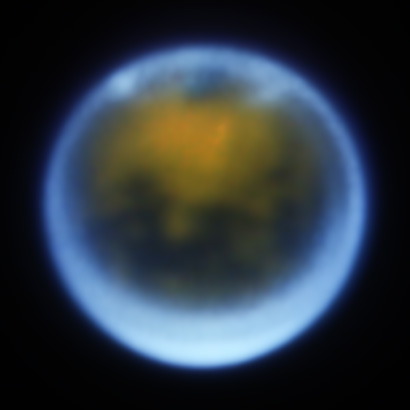Webb Space Telescope, Keck team up to study Saturn’s moon Titan
After the James Webb Space Telescope noticed clouds on Titan, a UC Berkeley astronomer stepped in to confirm and track their movement with the Keck telescope in Hawai'i

December 1, 2022

Evolution of clouds on Titan over 30 hours between Nov. 4 and Nov. 6, as seen by near-infrared cameras on the James Webb Space Telescope (top) and Keck Telescope. Titan’s trailing hemisphere seen here is rotating from left (dawn) to right (evening) as seen from Earth and the sun. Cloud A appears to be rotating into view, while Cloud B appears to be either dissipating, or moving behind Titan’s limb. Clouds are not long-lasting on Titan or Earth, so those seen on Nov. 4 may not be the same as those seen on Nov. 6. (Image credit: NASA/STScI/Keck Observatory/Judy Schmidt)
The James Webb Space Telescope (JWST) has turned its infrared cameras on Saturn’s moon Titan, giving astronomers another eye on the largest and one of the most unusual moons in the solar system.
The only satellite with a dense atmosphere, it’s also the only world besides Earth that has standing bodies of liquid on its surface, including rivers, lakes and seas — though the liquid is thought to be methane, ethane and other hydrocarbons that are toxic to humans.
The new observations, combined with those from Earth-bound telescopes, will help astronomers understand the weather patterns on Titan in advance of a NASA mission to the moon, called Dragonfly, that is scheduled for launch in 2027. A multirotor lander, Dragonfly will assess the habitability of Titan’s unique environment, investigate the moon’s unusual chemical stew, and search for signatures of water-based or hydrocarbon-based life.
Astronomers have observed Titan for decades, since before the Voyager encounter in 1980. Over approximately the past 25 years, they focused powerful ground-based and orbital telescopes on the satellite, complementing observations by NASA’s Cassini mission to Saturn, which observed Titan between 2004 and 2017. University of California, Berkeley, astronomer Imke de Pater led many Titan observations using high-resolution adaptive optics on the Keck Telescopes in Hawai’i.

A Keck telescope image of Titan taken on Nov. 7, 2022, showing bright clouds in the Northern Hemisphere at 11 o’clock and 1 o’clock. (Image credit: NASA/STScI/Keck Observatory/Judy Schmidt)
After the JWST imaged Titan on Nov. 4, the telescope’s Titan team saw what looked like two clouds in the atmosphere. Titan team lead Conor Nixon quickly emailed de Pater and Katherine de Kleer — a UC Berkeley Ph.D. who is now an assistant professor of planetary science and astronomy at the California Institute of Technology — to help confirm the clouds and track their movement with the Keck Telescope.
A series of Keck images taken about 30 and 54 hours later showed similar clouds — likely the same ones — but slightly displaced because of the moon’s rotation relative to Earth.
“We were concerned that the clouds would be gone when we looked at Titan one and two days later with Keck, but to our delight there were clouds at the same positions, looking like they might have changed in shape,” said de Pater, a UC Berkeley Professor of the Graduate School.
The power of JWST
Though the quality of the JWST and Keck images may look about the same to the untrained eye, de Pater noted that JWST has instruments that can measure aspects of Titan’s atmosphere that Keck cannot, complementing one another. In particular, JWST’s infrared spectroscopic capability allows it to pinpoint the altitudes of clouds and hazes with much better accuracy.

Saturn’s moon Titan captured by the James Webb Space Telescope’s NIRCam instrument on Nov. 4, 2022. The left image, taken through a 2.12-micron filter, shows clouds and lower atmospheric haze. The right image is a color composite using four filters. Kraken Mare is thought to be a methane sea; Belet is composed of dark-colored sand dunes; Adiri is a bright feature. (Image credit: NASA, ESA, CSA, A. Pagan [STScI]. Science: JWST Titan GTO Team)
In particular, at wavelengths where Earth’s atmosphere is opaque — that is, Titan cannot be seen from any Earth-based telescope — JWST can observe and provide information on the lower atmosphere and surface.
In early September, and again earlier this week, de Pater and de Kleer participated in an international observing campaign to catch the occultation by Titan of a distant star. Organized by Eliot Young, a senior program manager at the Southwest Research Institute in Boulder, Colorado, the occultation offered an opportunity to probe Titan’s atmospheric structure in more detail using the Keck Telescope and the Very Large Telescope in Chile. These observations are coordinated with occultations observed from other large telescopes and Doppler wind retrievals on Titan from the Atacama Large Millimeter Array, a radio telescope in Chile.
In conjunction with recent wind modeling results, these observations contribute to a broader understanding of atmospheres on Earth, on planets around other stars, and on our neighboring planets and moons in the solar system.
“This is some of the most exciting data we have seen of Titan since the end of the Cassini-Huygens mission in 2017, and some of the best we will get before NASA’s Dragonfly arrives in 2032,” said Zibi Turtle of Johns Hopkins University, who is Dragonfly’s principal investigator. “The analysis should really help us to learn a lot about Titan’s atmosphere and meteorology.”